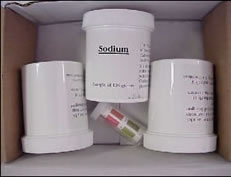|
[print
friendly page]
Drug
Information: G
GHB | Glutethimide & Methaqualone
GHB
(gamma hydroxybutyric acid)
Street
Names: Liquid Ecstasy, Scoop, Easy Lay, Georgia Home Boy, Grievous
Bodily Harm, Liquid X, and Goop1
 What are the different
forms of GHB? What are the different
forms of GHB?
- An odorless,
colorless liquid form
- White powder
material2
How is GHB used?
- Usually ingested
in a liquid mixture; most commonly mixed with alcohol
Who uses GHB?
- GHB has become
popular among teens and young adults at dance clubs and "raves."
- Body builders
sometimes use GHB for its alleged anabolic effects.
How does GHB get
to the United States?
- Because the drug
is easy to synthesize and manufacture, local operators usually handle
distribution.3
How much does GHB
cost?
- GHB is usually
sold by the capful, and sells for $5 to $25 per cap.4
What are some consequences
of GHB use?
- In lower doses,
GHB causes drowsiness, dizziness, nausea, and visual disturbances.
- At higher dosages,
unconsciousness, seizures, severe respiratory depression, and coma
can occur.
- Overdoses usually
require emergency room treatment, including intensive care for respiratory
depression and coma. As of November 2000, DEA documented 71 GHB-related
deaths.
- GHB has been
used in the commission of sexual assaults because it renders the
victim incapable of resisting, and may cause memory problems that
could complicate case prosecution.5
What are predatory
drugs?
1Drug
Enforcement Administration, Club Drugs: An Update, September
2001.
2Office of National Drug Control Policy, Drug
Facts: Club Drugs, May 2002.
3Drug Enforcement Administration, Club
Drugs: An Update, September 2001.
4Ibid.
5Ibid.
Glutethimide & Methaqualone
Glutethimide
(Doriden®)
was introduced in 1954 and methaqualone ("Quaalude" Sopor®)
in 1965 as safe barbiturate substitutes. Experience demonstrated, however;
that their addiction liability and the severity of withdrawal symptoms
were similar to those of barbiturates. By 1972, "luding out," taking
methaqualone with wine, was a popular college pastime. Excessive
use leads to tolerance, dependence, and withdrawal symptoms similar
to
those of barbiturates. In the United States, the marketing of methaqualone
pharmaceutical products stopped in 1984, and methaqualone was transferred
to Schedule I of the CSA. In 1991, glutethimide was transferred into
Schedule II in response to an upsurge in the prevalence of diversion,
abuse, and overdose deaths. Today, there is little medical use of
glutethimide in the United States. |

